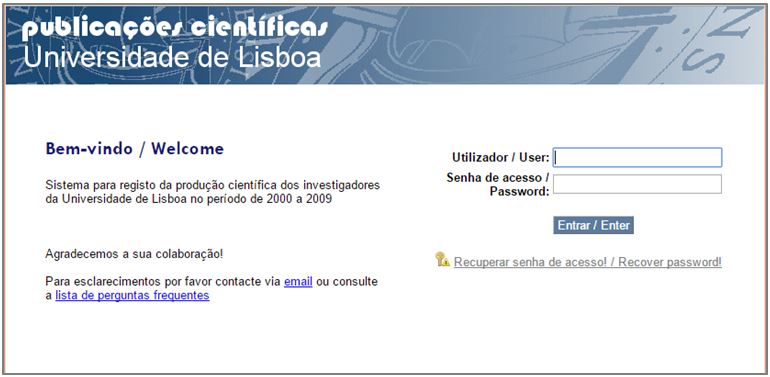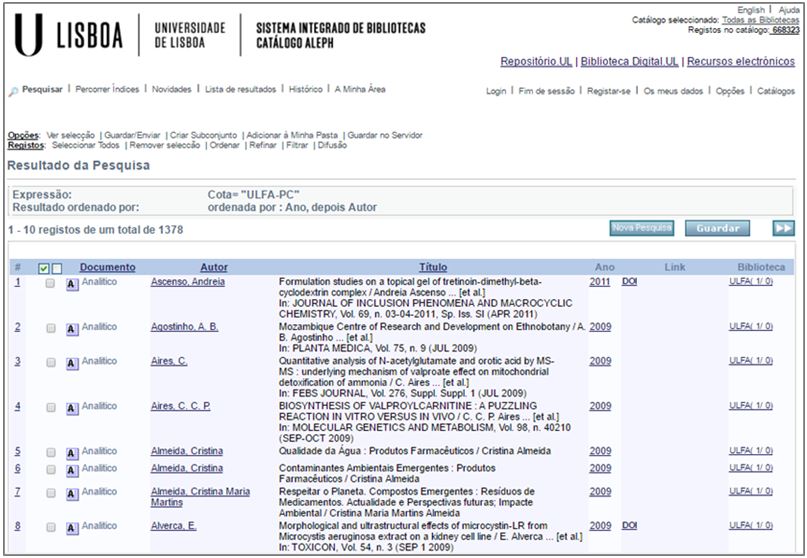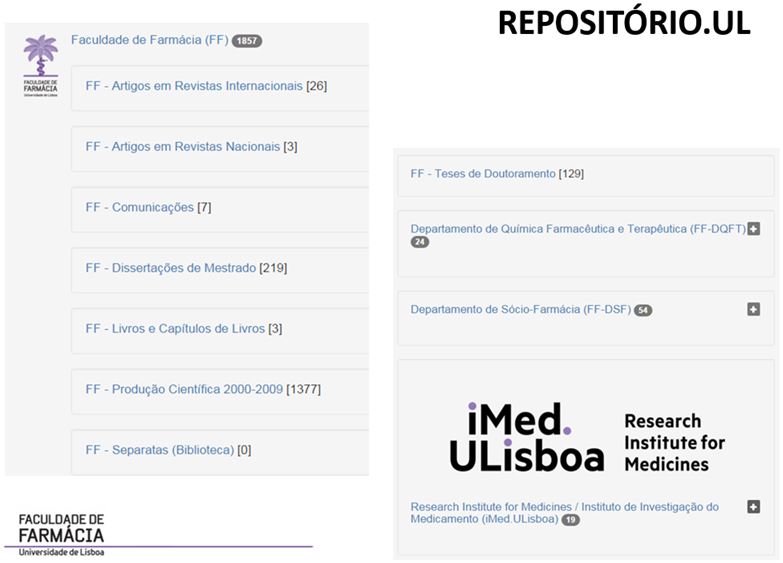Sílvia Costa Lopes1, António Manuel Freire2
1 Faculdade de Farmácia, Universidade de Lisboa, Lisboa, Portugal
2 Bibliosoft – Informática, Formação e Serviços, Lisboa, Portugal
Corresponding author: Sílvia Costa Lopes, slopes@ff.ulisboa.pt
Abstract
Introduction – Based on a previous project of University of Lisbon (UL) – a Bibliometric Benchmarking Analysis of University of Lisbon, for the period of 2000-2009 – a database was created to support research information (ULSR). However this system was not integrated with other existing systems at University, as the UL Libraries Integrated System (SIBUL) and the Repository of University of Lisbon (Repositório.UL). Since libraries were called to be part of the process, the Faculty of Pharmacy Library’ team felt that it was very important to get all systems connected or, at least, to use that data in the library systems.
Objectives – The main goals were to centralize all the scientific research produced at Faculty of Pharmacy, made it available to the entire Faculty, involve researchers and library team, capitalize and reinforce team work with the integration of several distinct projects and reducing tasks’ redundancy.
Methods – Our basis was the imported data collection from the ISI Web of Science (WoS), for the period of 2000-2009, into ULSR. All the researchers and indexed publications at WoS, were identified. A first validation to identify all the researchers and their affiliation (university, faculty, department and unit) was done. The final validation was done by each researcher.
In a second round, concerning the same period, all Pharmacy Faculty researchers identified their published scientific work in other databases/resources (NOT WoS). To our strategy, it was important to get all the references and essential/critical to relate them with the correspondent digital objects. To each researcher previously identified, was requested to register all their references of the ‘NOT WoS’ published works, at ULSR. At the same time, they should submit all PDF files (for both WoS and NOT WoS works) in a personal area of the Web server. This effort enabled us to do a more reliable validation and prepare the data and metadata to be imported to Repository and to Library Catalogue.
Results – 558 documents related with 122 researchers, were added into ULSR. 1378 bibliographic records (WoS + NOT WoS) were converted into UNIMARC and Dublin Core formats. All records were integrated in the catalogue and repository.
Conclusions – Although different strategies could be adopted, according to each library team, we intend to share this experience and give some tips of what could be done and how Faculty of Pharmacy created and implemented her strategy.
Keywords: Universities, Biomedical Research, Information Science, Information Systems, Community Networks, Cooperative Behavior
Introduction
Nowadays, one of the major challenges of scientific and academic institutions, particularly in the field of Health Sciences, is the Open Science. In Portugal it’s not different from Europe and the Open Access to scientific results is on the agenda of science policy. Therefore, Fundação para a Ciência e a Tecnologia (FCT), the national funding agency that supports science, technology and innovation in Portugal, decided to promote Open Access for all the scientific results, especially for funding research (1)(2). Another example of the importance of Open Access and Open Science is the decision of McGill University’s Montreal Neurological Institute to done all their scientific results conform to “open science” principles and made it freely available at the time of publication (3). Knowing that FCT vision is to “ensure that knowledge generated by scientific research is used fully, for economic growth and the well-being of all citizens” (4), Universities need to develop strategies that allow them to centralize all their scientific results and get visibility in order to be internationally recognized and get financial funding’s.
One major difficult at University of Lisbon is the absence of an Information System for the Researchers and the Scientific Research. Thus, in 2012, for a Bibliometric Benchmarking Analysis of University of Lisbon, for the period of 2000-2009 (5), a database was created to support research information (ULSR) (6). However this system was not integrated with other existing systems at University, as the UL Libraries Integrated System (SIBUL) and the Repository of University of Lisbon (Repositório.UL). Since libraries were called to be part of the process, the Faculty of Pharmacy Library’ team felt that it was very important to get all systems connected or, at least, to use that data in the library systems, namely with the repository, that is connected with the RCAAP – Repositório Científico de Acesso Aberto de Portugal (Portuguese Meta-Repository for Scientific Research) developed by FCT.
Objectives
The main goals were to centralize all the scientific research produced at Faculty of Pharmacy, made it available to the entire Faculty (and University), involve researchers and library team, capitalize and reinforce team work with the integration of several distinct projects and reducing tasks’ redundancy.
Methods
Our basis was the imported data collection from the ISI Web of Science (WoS), for the period of 2000-2009, into ULSR (Figure 1).

Figure 1 – UL Scientific Research (ULSR) database
All the researchers and indexed publications at WoS, were identified. A first validation to identify all the researchers and their affiliation (university, faculty, department and unit) was done. The final validation was done by each researcher.
In a second round, concerning the same period, all the researchers of Faculty of Pharmacy identified their published scientific work in other databases/resources (NOT WoS). To our strategy, it was important to get all the references and essential/critical to relate them with the correspondent digital objects. To each researcher previously identified, was requested to register all their references of the ‘NOT WoS’ published works, at ULSR. At the same time, they should submit all PDF files (for both WoS and NOT WoS works) in a personal area of the Web server. This effort enabled us to do a more reliable validation and prepare the data and metadata to be imported to Repository and to Library Catalogue.
Based on ULSR, all data was exported in XML format, analyzed and all fields were mapped to UNIMARC format (used in Portugal). Document type was identified for each record/document in order to get the mandatory fields created. Also, the authorities were analyzed since each scientific database and journals use authors name in different formats. In the next stage, after a last verification, all data was generated in UNIMARC in order to be imported to our bibliographic catalogue.
Finally, all UNIMARC records were exported to a new XML format and, after that, to Dublin Core format. All the subsets were created in order to be compliant with OpenAIRE and DRIVER guidelines. Another metadata set was created in XML with the purpose to be connected with DeGois System (a curriculum vitae platform for researchers). Lastly, all records were imported into Faculty of Pharmacy community at the Repositório.UL.
The last step is to add each digital object to the related record in the Repository and provide their permanent hyperlink (handle) into the catalogue record.
Results
558 documents related with 122 researchers, were added into ULSR. 1378 bibliographic records (WoS + NOT WoS) were converted into UNIMARC and Dublin Core formats. All records were integrated in the catalogue and repository (Figure 2 and 3). With this project, FF was the first and unique Faculty at University of Lisbon that retrieved the ULSR data and could make it available at repository.

Figure 2 – SIBULs’ Bibliographic Catalogue, with reference to 1378 document records.

Figure 3 – Faculty of Pharmacy Community at Repositório.UL.
At this stage, we started to add the digital objects in the repository records and link each record (by permanent hyperlink – handle) to the Library Catalogue record.
Conclusions
This experience is an ongoing project since research should always be available at the repository and library system. The next stage is to retrieve information for all the scientific research published by FF researcher since 2010 until 2015. The researchers, involved in several activities, need quality support services as libraries to help them to centralize and manage their publications and to create scientific reports for the financial agencies.
Although different strategies could be adopted, according to each library team, we intend to share this experience and give some tips of what could be done and how Faculty of Pharmacy created and implemented her strategy.
References
- Fundação para a Ciência e a Tecnologia. Política sobre o Acesso Aberto a Publicações Científicas resultantes de Projectos de I&D financiados pela FCT [Internet]. Lisboa: FCT; 2014 [cited 2016 Jan 29]. Available from:
https://www.fct.pt/documentos/PoliticaAcessoAberto_Publicacoes.pdf - Scharnhorst AM, Dijk EMS, Doorn PK, Berchum M van. The role of CRIS systems in measuring Open Access publications. 2016 Annual EA Conference: “Innovating the Gutenberg Galaxis. The role of peer review and open access in university knowledge dissemination and evaluation” [Internet]. 2016 [cited 2016 Apr 14]. Available from:
http://www.narcis.nl/publication/RecordID/oai%3Apure.knaw.nl%3Apublications%2Fd4b2fdce-8751-4c85-9b78-0c8445a06f4b - Owens B. Montreal institute going ’open to accelerate science. Science (80- ) [Internet]. 2016;351(6271):329–329. Available from:
http://www.sciencemag.org/cgi/doi/10.1126/science.351.6271.329 - FCT — About FCT [Internet]. [cited 2016 Apr 17]. Available from:
http://www.fct.pt/fct.phtml.en - Visser MS, Nederhof AJ. Bibliometric Benchmarking Analysis of University of Lisbon, 2000 – 2009/10 [Internet]. The Netherlands: Leiden University, Center for Science and Technology Studies; 2012 [cited 2016 Jan 20]. Available from:
http://www.ul-utl.edu.pt/php/printpdf.php?id_doc=57 - ULSR: publicações científicas da Universidade de Lisboa [Internet]. Lisboa: Universidade de Lisboa; c2011-2012 [cited 2016 Jan 25]. Available from:
http://rul-webpub01.ul.pt

